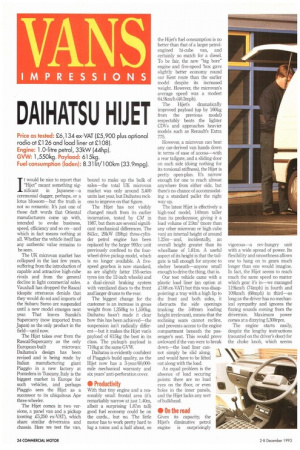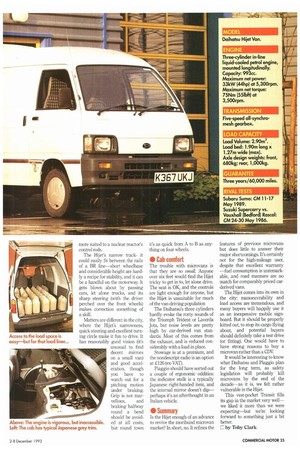DAIHATSU HIJET
Page 26

Page 27

If you've noticed an error in this article please click here to report it so we can fix it.
Price as tested: £6,134 ex-VAT (C5,900 plus optional radio at£126 and load liner at 108).
Engine: 1.0-litre petrol, 33kW (44hp).
GVW: 1,550kg. Payload: 615kg.
Fuel consumption (laden): 8.3114/100km (33.9mpg).
It would be nice to report that "Hijet" meant something significant in Japanese—a ceremonial dagger, perhaps, or a
lotus blossom but the truth is not so romantic. It's just one of these daft words that Oriental manufacturers come up with, intended to evoke business, speed, efficiency and so ow—and which in fact means nothing at all. Whether the vehicle itself has any authentic value remains to be seen.
The UK microvan market has collapsed in the last few years, suffering from the introduction of capable and attractive high-cube rivals and from the general decline in light commercial sales. Vauxhall has dropped the Rascal (despite strenuous denials that they would do so) and imports of the Subaru Sumo are suspended until a new model emerges next year. That leaves Suzuki's Supercarry (now imported from Japan) as the only product in the field—until now.
The Hijet takes over from the Rascal/Supercarry as the only European-built microvan: Daihatsu's design has been revised and is being made by Italian manufacturing giant Piaggio in a new factory at Pontedera in Tuscany. Italy is the biggest market in Europe for such vehicles, and perhaps Piaggio sees the Hijet as a successor to its ubiquitous Ape three-wheeler.
The Hijet comes in two versions, a panel van and a pickup (costing £5,250 ex-VAT), which share similar drivetrains and chassis. Here we test the van, bound to make up the bulk of sales—the total UK microvan market was only around 3,400 units last year, but Daihatsu reckons to improve on that figure.
The Hijet has not visibly changed much from its earlier incarnation, tested by CM in 1987, but there are several significant mechanical differences. The 843c-c, 29kW (39hp) three-cylinder petrol engine has been replaced by the larger 993cc unit previously confined to the fourwheel-drive pickup model, which is no longer available. A fivespeed gearbox is now standard, as are slightly fatter 155-series tyres (on the 12-inch wheels) and a dual-circuit braking system with ventilated discs to the front and larger drums to the rear.
The biggest change for the customer is an increase in gross weight from 1,350kg to 1,550kg. Daihatsu hasn't made it clear how this has been achieved—the suspension isn't radically different—but it makes the Hijet van's payload of 615kg the best in its class. The pickup's payload is 710kg at the same GVW.
Daihatsu is evidently confident of Piaggio's build quality, as the Hijet now has a 3-year/60,000mile mechanical warranty and six years' anti-perforation cover.
• Productivity
With that tiny engine and a reasonably small frontal area (it's remarkably narrow at just 1.40m, albeit a surprising 1.87m tall) good fuel economy could be on the cards... but no. The little motor has to work pretty hard to lug a tonne and a half about, so the Hijet's fuel consumption is no better than that of a larger petrolengined hi-cube van, and certainly no match for a diesel. To be fair the new "big bore" engine and five-speed 'box gave slightly better economy round our Kent route than the earlier model despite its increased weight. However, the microvan's average speed was a modest 64.9km/h (40.3mph).
The Hijet's dramatically improved payload (up by 160kg from the previous model) respectably beats the lighter CDVs and approaches heavier models such as Renault's Extra 775.
However, a microvan can beat any car-derived van hands down in terms of ease of access—with a rear tailgate, and a sliding door on each side (doing nothing for its torsional stiffness), the Hijet is pretty open-plan. It's narrow enough for one to reach almost anywhere from either side, but there's no chance of accommodating a standard pallet the right way up.
The latest Hijet is effectively a high-roof model, 140min taller than its predecessor, giving it a load volume of 2.9m3 (more than any other microvan or high cube van) an internal height of around 1.25m—and, incidentally, an overall height greater than its wheelbase of 1.81m. A useful aspect of its height is that the tailgate is tall enough for anyone to shelter beneath—anyone small enough to drive the thing, that is.
Our test vehicle came with a plastic load liner (an option at £108 ex-VAT) but this was disappointing: a tray with a high lip to the front and both sides, it obstructs the side openings (making the 540mtn loading height irrelevant), means that the reclining seats cannot recline, and prevents access to the engine compartment beneath the passenger's seat. This would prove awkward if the van were to break down—the load liner cannot simply be slid along, and would have to be lifted out along with the load.
An equal problem is the absence of load securing points: there are no load eyes on the floor, or even holes in the inner panels, and the Hijet lacks any sort of bulkhead.
• On the road
Given its capacity, the Hijet's diminutive petrol engine is surprisingly vigorous—a rev-hungry unit with a wide spread of power. Its flexibility and smoothness allows one to hang on to gears much longer than one would imagine. In fact, the Hijet seems to reach much the same speed no matter which gear it's in—we managed 119km/h (74mph) in fourth and 109km/h (68mph) in third—as long as the driver has no mechanical sympathy and ignores the fizzing sounds coming from the drivetrain. Maximum power comes at a dizzying 5,300rpm.
The engine starts easily, despite the lengthy instructions (mounted on the driver's door) for the choke knob, which seems more suited to a nuclear reactor's control rods.
The Hijet's narrow trackit could easily fit between the rails of a BR line—short wheelbase and considerable height are hardly a recipe for stability, and it can be a handful on the motorway. It gets blown about by passing cars, let alone trucks, and its sharp steering (with the driver perched over the front wheels) makes correction something of a skill, Matters are different in the city, where the Hijet's narrowness, quick steering and excellent turning circle make it fun to drive. It has reasonably good vision (it's unusual to find decent mirrors on a small van) and good acceleration, though you have to watch out for a pitching motion under braking Grip is not mar vellous, and braking halfway round a bend should be avoided at all costs, but round town it's as quick from A to B as anything on four wheels.
• Cab comfort The trouble with microvans is that they are so small. Anyone over six feet would find the Hijet tricky to get in to, let alone drive. The seat is OK, and the controls are light enough for anyone, but the Hijet is unsuitable for much of the van-driving population
The Daihatsu's three cylinders hardly evoke the rorty sounds of the Triumph Trident or Laverda Jota, but noise levels are pretty high by car-derived van standards. Most of this comes from the exhaust, and is reduced considerably with a load in place.
Stowage is at a premium, and the nondescript radio is an option at £126 (ex-VAT).
Piaggio should have sorted out a couple of ergonomic oddities: the indicator stalk is a typically Japanese right-handed item, and the internal mirror doesn't dip— perhaps it's an afterthought in an Italian vehicle.
• Summar)!
Is the Hijet enough of an advance to revive the moribund microvan market? In short, no. It refines the features of previous microvans but does little to answer their major shortcomings. It's certainly not for the high-mileage user, despite that excellent warranty —fuel consumption is unremarkable, and road manners are no match for comparably priced carderived vans.
The Hijet comes into its own in the city: manoeuvrability and load access are tremendous, and many buyers will happily use it as an inexpensive mobile signboard. But it should be properly kitted out, to stop its cargo flying about, and potential buyers should definitely take a test drive (or fitting). One would have to have strong reasons to buy a microvan rather than a CDV It would be interesting to know what Daihatsu and Piaggio plan for the long term, as safety legislation will probably kill microvans by the end of the decade—as it is, we felt rather vulnerable in the Hijet.
This vest-pocket Transit fills its gap in the market very well— we liked it more than we were expecting—but we're looking forward to something just a bit better.
E by Toby Clark




















































































